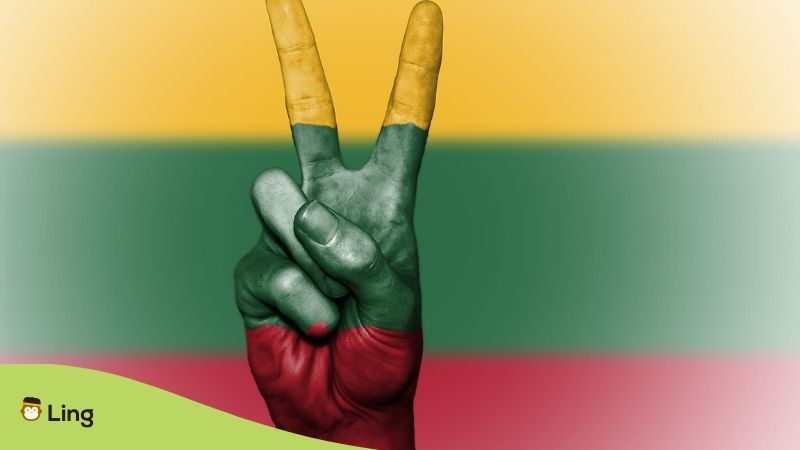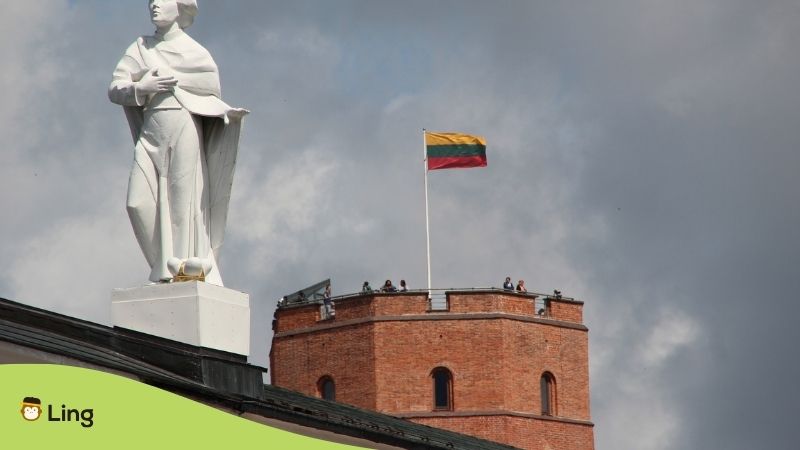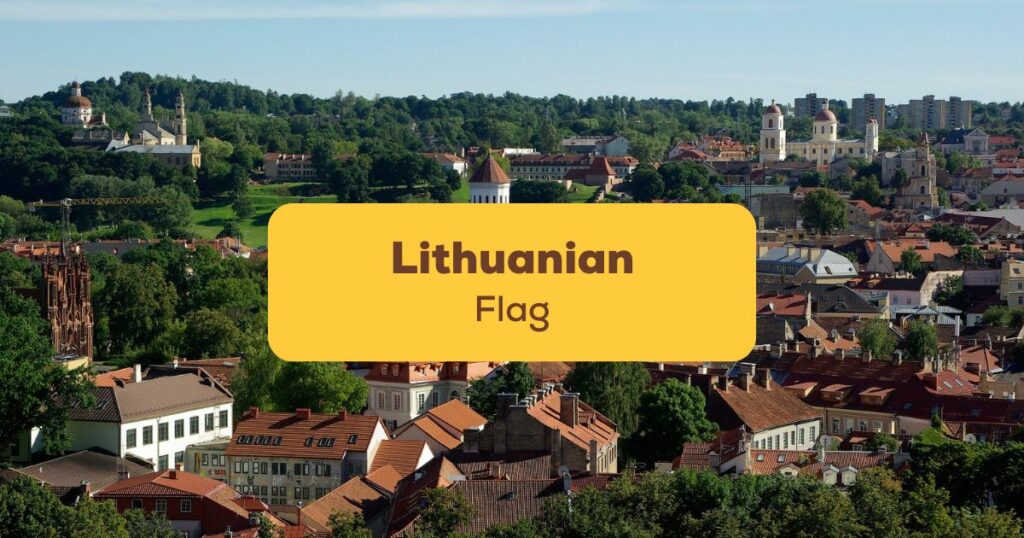If you ever find yourself in Lithuania, you’ll definitely see the iconic Lithuanian flag fluttering in the breeze and rising high to the sky. This historical flag is certainly hard to miss with its vibrant yellow stripe on top, a bright red on the bottom, and a grassy green sandwiched in the middle.
There’s more to this flag, and the flags of other countries, than just being a piece of cloth. The designs of flags are never random, in fact, there are many secret meanings embedded into flags. With a little research, you can dissect the symbols, colors, and coat of arms to discover what they represent, because chances are, they do reflect something.
The flag of Lithuania holds historical significance. It represents the Lithuanian nation, its people, and its culture. It is a respectful gesture to learn about a country’s flag, especially if you visit the country as a tourist. In addition to packing your brain with facts about the flag’s meanings, it’s just fun to pull the curtain back on a country’s flag and know its secrets! Want to learn more about the flag of this country? Read on below! There’s even some related vocabulary in the Lithuanian language for you to learn at the end!
Lithuanian Flags – There Are Two!
Did you know Lithuania actually has two flags? It’s true! The common and national version is the tricolor flag boasting the yellow, green, and red stripes. The other, lesser known variant is a bit more complex in design and is considered the state flag of Lithuania or Lithuania flag. You might be thinking, “Isn’t it a bit of overkill to have two flags?” Well, both flags serve a unique purpose and carry their own meanings, so let’s discover those together!
Tricolor Flag Of Lithuania
This flag was the earliest official flag, being adopted in 1918, and is the current flag hoisted by Lithuania. It’s got a standard 3:5 ratio (though it was 1:2 in 1989.) Fun fact: striped flags emerged rather late in history! It wasn’t until the French Revolution when striped country flags started springing up, when France replaced their once plain white flag with a striped version. In the 19th century, most European nations adopted striped national flags.
The equal weight (thickness) of the stripes on the flag of Lithuania means universal equality before the law. This design choice goes hand-in-hand with the other flags in the European Union that adopt the same striped pattern for their own flags. Another thing European countries tend to mimic universally for their flags? The fact that their flag colors are pulled from the nation’s coat of arms. Let’s break those down next!

The Colors In The Lithuanian Flag
Yellow (Geltona)- This beaming ray of yellow skates on top of the flag as the gold and glowing sun beaming over Lithuania.
Green (žalias) – Does this green remind you of foliage and meadows? Well, you’re on the right track! The green stripe in the middle means forests.
Red (Raudona) – At the bottom, the splash of red represents the blood spilled by the Lithuanian people who have bravely defended Lithuania’s freedom in the country’s history. This red banner is an emotional reminder that Lithuania has an important past you should consider learning more about in case you ever want to visit this country yourself and connect to the Lithuanian culture.
History Of The Tricolor Flag
The history of the Lithuania flag is quite long and has lots of layers to it. Lithuania went a long time without being able to choose their own flag due to the country being incorporated into the Russian Empire. Despite this obstacle, Lithuanian communities first developed color ideas, including the ones they would eventually use for the current flag, in the second half of the 19th century.
The colors of the flag went through much deliberation and discussion beginning as early as 1905. In 1917, when there was a prospect that Lithuania was on the verge of establishing independence as a state, the discussions fired up. In fact, there was a debate held to come up with what colors the flag should have. Painter Antanas Žmuidzinavičius thought of a green and red color scheme because of their prevalence in national costumes and in sashes. This choice was agreed upon by Lithuanians, even those living in the United States, but later, the flag was deemed a little too “gloomy,” so it was back to the drawing board.
Tadas Daugirdas, an archaeologist and expert in heraldry, was the next big brain to come up with an idea for the national flag. He had the brilliant idea of adding a thin yellow stripe to symbolize the dawn, popping it in between the green of the forests and the crimson-red stripe to make the flag livelier.
Eventually, the above idea was taken into consideration and tweaked into the final version of the national flag we see today. On April 19, 1918, the three equal horizontal stripes in yellow, green, and red were approved by a commission established by the Council of Lithuania. It was at first only the interim design, but it was gradually accepted by the nation. Wow, I sure wonder if other flags have gone through such a dramatic arc of design and redesign!
Soviet Occupation And The National Flag
When the Soviet Union occupied Lithuania on June 15, 1940, the flag that Lithuanians worked so hard to implement and display was forced to retire. All symbols expressing Lithuanian freedom were banned, including the very flag that expressed its statehood. The tricolor flag was more or less kept, though, with the Soviet occupation adding a golden hammer and sickle symbol in the bottom left corner.
Through all the troubles, the Lithuanian flag refused to go away. It was secretly hoisted in public on every February 16th and secretly kept inside the homes of Lithuanians that wanted to remind themselves of the Lithuanian commitment to resistance. After the fall of the Soviet occupation, the tricolor flag made its triumphant return in all its glory on October 7, 1988.
State Flag Of Lithuania
The first documented use of this flag was found super early – in 1410! The unique design of this version depicts a brave knight clad in white armor, a sword raised proudly in his right hand, and a blue shield branded with a cross marking in the other. This figure is seen riding a prancing and majestic-looking white horse as if fearlessly charging into battle. This interesting symbol is known as Vytis – a horseman who dedicates himself to fighting enemies.
Lithuanian public figure, Jonas Basanavičius, proposed the flag of the Grand Duchy of Lithuania be recognized as the national flag, but due to the negative implications behind this design that seemed to trace back to a messy revolution, the proposal was rejected. And so, the striped flag remained as the main Lithuanian flag that we can see displayed in flagpoles, flying atop buildings and institutions.
Good news for fans of this whimsical design (like me!): This flag was kept on and adopted officially in 2004 as the Lithuanian state flag. It is still seen around, though not as commonly as the national flag. This flag is required to be used in the Royal Palace of Lithuania, displayed high for the republic to see. Also, the flag must be displayed in Vytautas, the Great Military museum in Kaunas.

Rules Of Hoisting The Lithuanian Flag
Did you know there are certain rules and regulations behind the flag of Lithuania that the Lithuanian state observes carefully and seriously? The laws regulate the use of the Lithuania flag and how it should be treated in accordance with official ceremonies and display purposes, among other things. Below is a list of a few of the interesting ways the flag is used in Lithuania.
- Citizens of the Republic of Lithuania (and other persons) must always show respect to the flags.
- The flag must be kept in mint condition and never be soiled or faded.
- The national flag of Lithuania must be displayed on a 24-hour basis near and/or over the following buildings: the Government and the ministries of the Republic of Lithuania, the Presidential Palace, the Bank of Lithuania, and other similar public institutions, conference halls, or offices.
- As a sign of mourning, the national flag of Lithuania may be flown one-third way down the flagpole to mark the occasion.
Words Related To The Lithuanian Flag
Planning on flexing these new facts about the national flag of Lithuania to impress your friends? Then you should know how to say some Lithuanian words, too! Check out the table below for a list of essential words that surround the historical national flag.
| English | Lithuanian | Pronunciation |
|---|---|---|
| Flag | Vėliava | Vel-lah-vah |
| Symbol | Simbolis | Sim-BOHL-iss |
| History | Istorija | Ees-tore-ee-yah |
| Armorial bearings | Ginklu guoliai | Geen-kloo gwoh-lay |
| Stripes | Juostelės | Yoo-oh-stAH-less |
| Tradition | Tradicija | Tra-dee-tzee-yah |
Learn Lithuanian With Ling
There you have it, language learners! We’ve gone through the meanings of the flag of Lithuania – both of them – diving deep into the color meanings, the symbolism, and even the rules attached to hoisting the flag. Additionally, we even covered important and helpful Lithuanian words that will help you show off all your new flag knowledge!
Do you want to learn more Lithuanian beyond just what comes from knowing handy informational nuggets on the flag? You should check out the Ling app! It’s loaded with tons of language-learning lessons that will take your Lithuanian learning to the next level. From vocabulary lessons to interesting audio listening activities, Ling has got what you need to assist you on your path to sounding like a native Lithuanian speaker.
Check it out on the App Store or Google Play Store and get started with learning Lithuanian or any of the other 60+ languages available for you to browse. With Ling’s mobile app, your lessons can be taken on-the-go and will be ready whenever you are!


































































